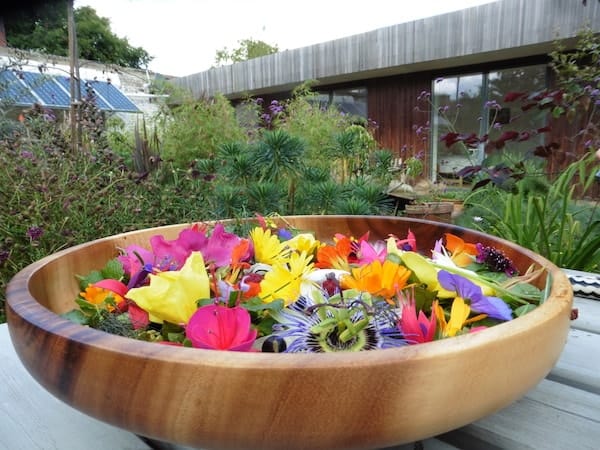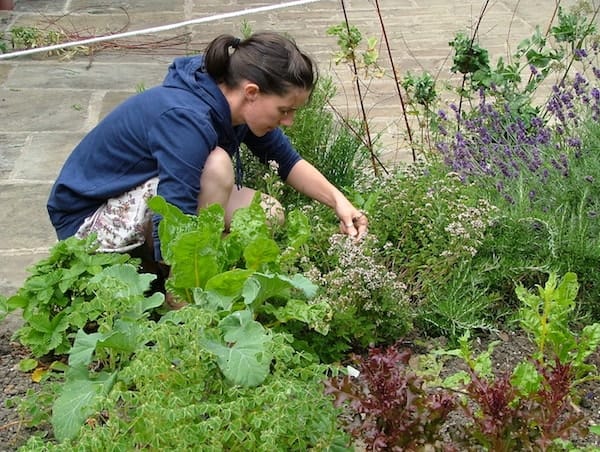For 30 years, forest gardens have been planted in cities, gardens and parks in temperate climates around the world. Tomas Remiarz explores how this maturing, self-reproducing system is designed for abundance
Forest gardens are spaces where trees, shrubs, herbs, vegetables and flowers grow together in mixed patches, and in many layers. An agroecologist might call them a multi-storey cropping system. To me, they are unique spaces in which humans meet nature halfway, and where both feed off one another.
It is both an ancient, and a very new idea. In many tropical parts of the world, they have existed as home gardens since time immemorial. In the colder parts of the Northern hemisphere, they took off after Robert Hart returned from his travels in Kerala, southern India, harbouring dreams of edible forests.

A freshly foraged salad from Marietta Castellino’s garden in Margate, Kent, containing more than 100 species
In the three decades following Hart’s discovery, hundreds of experimental forest gardens have been planted all over the world. They can be found in cities and rural sites; in households and neighbourhoods; in community gardens and parks; and in market gardens and plant nurseries.
So how do you make a forest gardener? Forest gardens are complex. There is no way around that. In fact, this partly explains why we set them up in the first place, eager to find a space more natural and wild than a wheat field or pine plantation.
To deal with this complexity, the competent forest gardener needs a diverse toolkit, each tool drawing upon four domains of understanding. Forest gardening is multidisciplinary; borrowing skills from ecology, horticulture, design, and communication alike.
Like the sound of people-powered media?
As any good gardener will understand, gardening is a lot more than bending plants to our will. Working with living communities means giving them what they need, in the hope they will return the favour. In fact, gardening is always an act of hope. It requires patience, and asking from the land as well as giving to it. It challenges us to shape the natural processes around us, while respecting their own space.
Based on an understanding of natural patterns, permaculture is a design approach that particularly chimes with forest gardening, and many of the best forest gardens have been created by people experienced in permaculture. The meaning of design as a decorative pattern is also relevant, as pleasure derived from the beauty of the natural world is one of the main motivations for many gardeners.
Teamwork is also vital, and forest gardeners rarely work entirely on our own. Family members, contractors and neighbours, all have a bearing on what goes on. In community and public spaces, the web of human interaction can be as complex as the web connecting plants, animals and fungi. Communication, decision making, and skill sharing are crucial aspects of working together in any of these situations.
All-purpose landscapes
Forest gardens can help generate and maintain many forms of wealth within our communities.
In the Scottish Borders, Graham Bell and Nancy Woodhead have created a family paradise over the past 25 years, growing fruit, vegetables, medicine and fuel in their back garden. Harvesting more than a tonne of food from their 25m by 30m space, they use fresh produce in their kitchen every day of the year. The couple bring in extra income by helping other people to set up their very own self-sufficient food forests.
In Manchester, the residents of Bentley House estate in Hulme came together to cultivate a neglected patch between a block of flats. They turned it into a source of beauty and cohesion that is still thriving 15 years later.
Made to create abundance, a forest garden can look after us if we look after it
In North Yorkshire, smallholder Rachel Benson has spent a decade turning her homestead into a market garden that gives her financial independence, and her community access to healthy, local produce – and a whole new taste experience. She runs an ingenious ‘community supported preserve’ scheme, delivering monthly packages of “something sweet, something savoury, and something to drink” to her customers via tandem bike.
Meanwhile, in Seattle, US, the gardeners of Beacon Food Forest have been busy transforming a municipal lawn into a diverse food forest accessible to people from many different backgrounds. And in small towns from the north of England to central Germany, edible perennial plantings are helping to transform entire towns. All these are examples of creating real wealth from the living land, with the help and ingenuity of people.
Thirty years into its life, the forest garden has become a maturing, self-reproducing system that keeps creating soil, making more plants and more forest gardeners. It is generating biological and material resources as well as knowledge and inspiration.

‘A forest garden is a place where nature and people meet halfway.’ Image: Andrew Chapman
Made to create abundance, a forest garden can look after us if we look after it. The living community of plants, animals and fungi in constant dynamic interplay can teach us a lot about the nature of relationships in ecosystems, and even point towards finding our own place in the intricate game of life.
Forest gardens can also help us practice being part of a purposeful community of people maintaining and benefiting each other. The best forest gardens are great examples of collaboration across species barriers, including us as a keystone species. Observing and becoming part of these gardens may inspire us to search out similarly useful patterns in our interactions with each other. Who knows? They may even help us develop our own metaphors for more resilient and compassionate societies. This was the great dream of Robert Hart when he first brought the idea from India, and put it into Shropshire soil.
Tomas Remiarz is the author of Forest Gardening in Practice: An Illustrated Practical Guide for Homes, Communities & Enterprises, an in-depth review of forest gardening, published by Permanent Publications.
